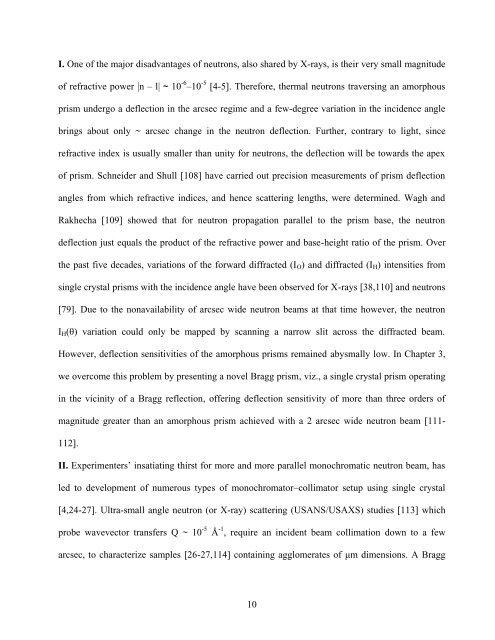PHYS01200804001 Sohrab Abbas - Homi Bhabha National Institute
PHYS01200804001 Sohrab Abbas - Homi Bhabha National Institute
PHYS01200804001 Sohrab Abbas - Homi Bhabha National Institute
Create successful ePaper yourself
Turn your PDF publications into a flip-book with our unique Google optimized e-Paper software.
I. One of the major disadvantages of neutrons, also shared by X-rays, is their very small magnitude<br />
of refractive power |n – l| ~ 10 -6 –10 -5 [4-5]. Therefore, thermal neutrons traversing an amorphous<br />
prism undergo a deflection in the arcsec regime and a few-degree variation in the incidence angle<br />
brings about only ~ arcsec change in the neutron deflection. Further, contrary to light, since<br />
refractive index is usually smaller than unity for neutrons, the deflection will be towards the apex<br />
of prism. Schneider and Shull [108] have carried out precision measurements of prism deflection<br />
angles from which refractive indices, and hence scattering lengths, were determined. Wagh and<br />
Rakhecha [109] showed that for neutron propagation parallel to the prism base, the neutron<br />
deflection just equals the product of the refractive power and base-height ratio of the prism. Over<br />
the past five decades, variations of the forward diffracted (I O ) and diffracted (I H ) intensities from<br />
single crystal prisms with the incidence angle have been observed for X-rays [38,110] and neutrons<br />
[79]. Due to the nonavailability of arcsec wide neutron beams at that time however, the neutron<br />
I H (θ) variation could only be mapped by scanning a narrow slit across the diffracted beam.<br />
However, deflection sensitivities of the amorphous prisms remained abysmally low. In Chapter 3,<br />
we overcome this problem by presenting a novel Bragg prism, viz., a single crystal prism operating<br />
in the vicinity of a Bragg reflection, offering deflection sensitivity of more than three orders of<br />
magnitude greater than an amorphous prism achieved with a 2 arcsec wide neutron beam [111-<br />
112].<br />
II. Experimenters’ insatiating thirst for more and more parallel monochromatic neutron beam, has<br />
led to development of numerous types of monochromator–collimator setup using single crystal<br />
[4,24-27]. Ultra-small angle neutron (or X-ray) scattering (USANS/USAXS) studies [113] which<br />
probe wavevector transfers Q ~ 10 -5 Å -1 , require an incident beam collimation down to a few<br />
arcsec, to characterize samples [26-27,114] containing agglomerates of μm dimensions. A Bragg<br />
10
















